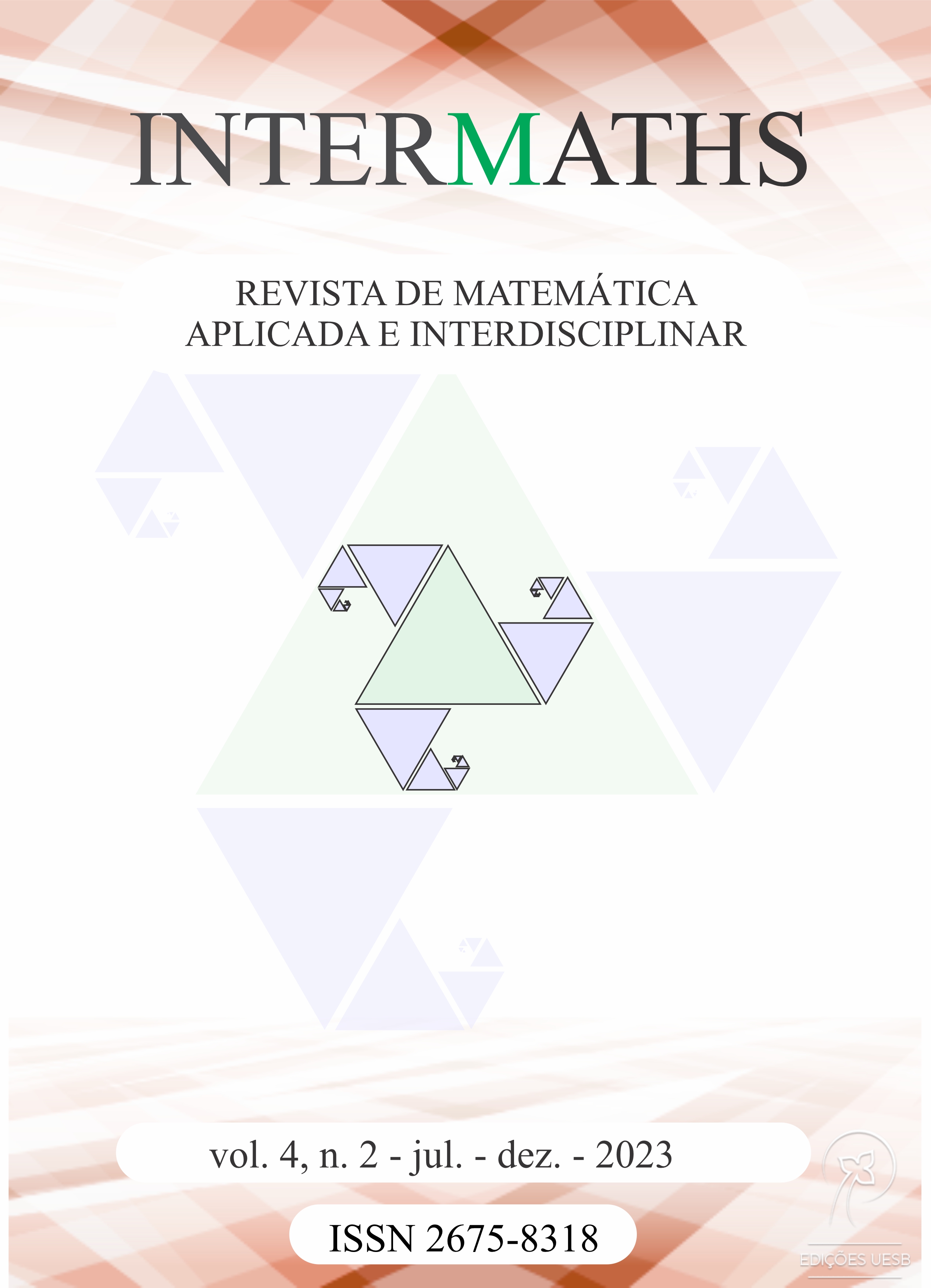On the reachability tube of non-Newtonian first-order linear differential equations
DOI:
https://doi.org/10.22481/intermaths.v4i2.13991Keywords:
α-generators, non-Newtonian calculus, non-Newtonian differential equations, external perturbations, reachability tubeAbstract
A problem of practical interest is the determination of the reachability sets of ordinary differential equations with an external perturbation, or with a control. This problem can be extended to non-Newtonian spaces generated by continuous and injective functions α. This paper presents the problem of determining the reachability tube of a family of non-Newtonian first-order linear differential equations with an external perturbation, or with a control, that belongs to a set of functions that are α-continuous and α-bounded. The reachability tube is determined explicitly in three non-Newtonian spaces that are associated with three α-generators. The results obtained are illustrated numerically.
Downloads
Metrics
References
M. Grossman and R. Katz, Non-Newtonian calculus, Lee Press, Pigeon Cove, Massachusetts: 1972.
E. Pap, “g-calculus”, Novi Sad Journal of Mathematics, vol. 23, no. 1, pp. 145–156, 1993. http://elib.mi.sanu.ac.rs/files/journals/nsjom/32/nsjomn32p145-156.pdf
N. Ralevic, “Some new properties of the g-calculus”. Novi Sad Journal of Mathematics, vol. 24, no. 1, pp. 139–157, 1993. http://elib.mi.sanu.ac.rs/files/journals/nsjom/ 34/nsjomn34p139-157.pdf
E. Borges, “A possible deformed algebra and calculus inspired in non extensive thermostatistics”, Physica A: Statistical Mechanics and its Applications, vol. 340, no. 1, pp. 95–101, 2004. http://doi.org/10.1016/j.physa.2004.03.082
W. Dunham, The calculus gallery: Masterpieces from Newton to Lebesgue, Princeton University Press, New Jersey: 2005.
D. Stanley, “A multiplicative calculus”, Problems, Resources, and Issues in Mathematics Undergraduate Studies, vol. 10, no. 4, pp. 310–326, 1999. http://doi.org/10.1080/ 10511979908965937
E. Pap, D. Takaci and A. Takaci, “The g-operational calculus”. International Journal of Uncertainty, Fuzziness and Knowledge-Based Systems, vol. 10, no. supp01, pp. 75–88, 2002. http://doi.org/10.1142/S0218488502001843
G. Kaniadakis, “Statistical mechanics in the context of special relativity”, Physical Review E, vol. 66, no. 5, p. 056125, 2002. http://doi.org/10.1103/PhysRevE.66.056125
G. Kaniadakis, “Statistical mechanics in the context of special relativity II”, Physical Re- view E, vol. 72, no. 3, p. 036108, 2005. http://doi.org/10.1103/PhysRevE.72.036108
A. E. Bashirov, E. M. Kurpınar and A. Özyapıcı, “Multiplicative calculus and its applications”, Journal of Mathematical Analysis and Applications, vol. 337, pp. 36–48, 2008. http://doi.org/10.1016/j.jmaa.2007.03.081
A. Kaabouchi, L. Nivanen, Q. Wang, J. Badiali and A. Méhauté, “A mathematical structure for the generalization of conventional algebra”, Open Physics, vol. 7, no. 3, pp. 549–554, 2009. http://doi.org/10.2478/s11534-009-0046-4
A. E. Bashirov, E. Mısırlı, Y. Tandogdu and A. Özyapıcı,“On modeling with multiplicative differential equations”, Applied Mathematics. A Journal of Chinese Universities, vol. 26, no. 4, pp. 425–438, 2011. http://doi.org/10.1007/s11766-011-2767-6
C. Turkmen and F.Basar, “Some basic results on the sets of sequences with geometric calculus”, First International Conference on Analysis and Applied Mathematics: ICAAM 2012. vol. 1470, pp. 95–98, 2012. http://doi.org/10.1063/1.4747648
A. F. Cakmak and F. Basar, “Some new results on sequence spaces with respect to non- Newtonian calculus”, Journal of Inequalities and Applications, vol. 2012, no. 1, pp. 228, 2012. http://doi.org/10.1186/1029-242X-2012-228
G. Kaniadakis, “Theoretical foundations and mathematical formalism of the power-law tailed statistical distributions”, Entropy, vol. 15, no. 10, pp. 3983–4010, 2013. http://doi. org/1099-4300/15/10/3983
A. F. Cakmak and F. Basar, “Certain spaces of functions over the field of non-Newtonian complex numbers”, Abstract and Applied Analysis, pp. 236124, 2014. http://doi.org/10. 1155/2014/236124
S. Kalajdzievski, An illustrated introduction to topology and homotopy, Chapman and Hall/CRC, New York: 2015. https://doi.org/10.1201/b15023
B. Turan and C evik, “A note on the equivalence of some metric and non-Newtonian metric results”, Turkish Journal of Mathematics and Computer Science, vol. 7, pp. 56–58, 2017.
W. Campillay-Llanos, F. Guevara-Morales, M. Pinto, R. Torres, “Differential and integral proportional calculus: how to find a primitive for f(x) = 1/√2πe−(1/2)x2”, International Journal of Mathematical Education in Science and Technology, vol. 52, no. 3, pp. 463–476, 2020. https://doi.org/10.1080/0020739X.2020.1763489
M. Pinto, R. Torres, W. Campillay-Llanos, F. Guevara-Morales, “Applications of proportional calculus and non-Newtonian logistic growth model”, Proyecciones (Antofagasta), vol. 39, no. 6, pp. 1471–1513, 2020. https://doi.org/10.22199/issn. 0717-6279-2020-06-0090
M. Czachor, “Unifying aspects of generalized calculus”, Entropy. vol. 22, no. 10, p. 1180, 2020. https://doi.org/10.3390/e22101180
G. Kaniadakis, M. Baldi, T. Deisboeck, C. Grisolia, D. Hristopulos, A. Scarfone, A. Sparavigna, T. Wada and U. Lucia, “The κ-statistics approach to epidemiology”, Scientific Reports, vol. 10, p. 19949, 2020. https://doi.org/10.1038/s41598-020-76673-3
D. F. M. Torres, “On a non-Newtonian calculus of variations”, Axioms, vol. 10, no. 3, p. 171, 2021. https://doi.org/10.3390/axioms10030171
M. Czachor, “Non-Newtonian mathematics instead of non-Newtonian physics: dark matter and dark energy from a mismatch of arithmetics”, Foundations of Science, vol. 26, pp. 75– 95, 2021. https://doi.org/10.1007/s10699-020-09687-9
Published
How to Cite
Issue
Section
License
Copyright (c) 2023 INTERMATHS

This work is licensed under a Creative Commons Attribution 4.0 International License.
- Responsibility: The scientific content and the opinions expressed in the manuscript are the sole responsibility of the author(s).
- Copyrights: INTERMATHS.
- All content of Revista INTERMATHS/INTERMATHS journal is licensed under a Creative Commons - Atribuição 4.0 Internacional







